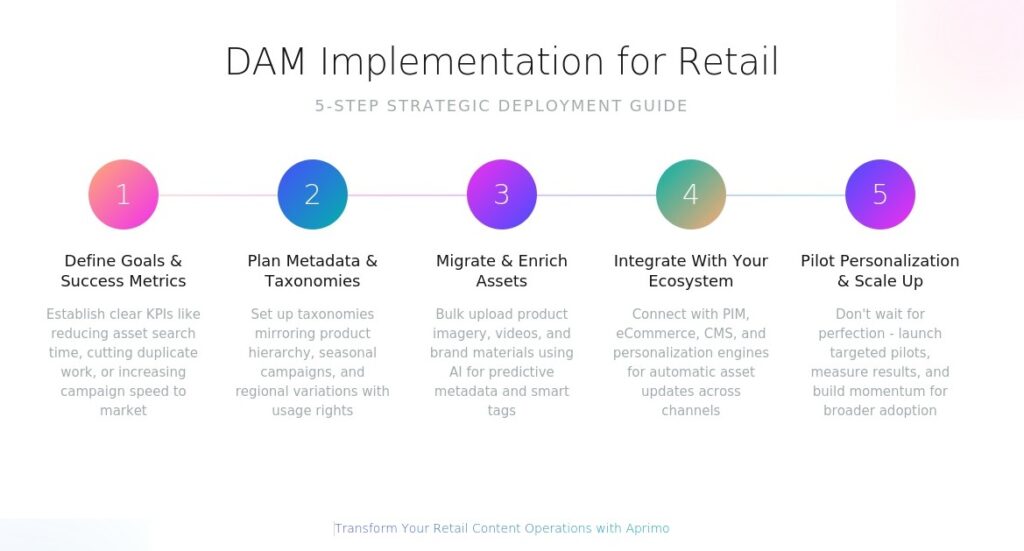The Power of DAM for Retail


Retail digital transformation demands intelligent content operations that go far beyond traditional file storage.
- Companies with strong omnichannel strategies retain more customers than those with weak execution.
- Multichannel customers spend more than single-channel customers, making omnichannel excellence a direct revenue driver.
- Dynamic asset delivery improves SEO, page speed, and customer experience.
- Social commerce is projected to reach $17.83 trillion globally by 2033, requiring seamless asset management across platforms.
Modern retailers need DAM platforms that integrate AI automation, support omnichannel personalization, and scale with emerging commerce channels to stay competitive.
Retailers are under more pressure than ever to deliver consistent, personalized experiences at scale. Shoppers expect rich, relevant, and lightning-fast content across every channel, from PDPs and PLPs to emails and in-store displays. Yet many teams still lose hours searching for assets, re-creating work, or struggling to keep campaigns on-brand. That’s where DAM for retail comes in.
Digital asset management for retail brands has evolved far beyond storage. Modern platforms now act as intelligent engines that surface the right content instantly, recommend what to create next, and deliver optimized assets across every touchpoint. With digital transformation underway, brands need faster launches, stronger brand consistency, and experiences that resonate with customers, whether they’re known, anonymous, or anywhere in between.
What is DAM for Retail in 2025?
Digital asset management (DAM for retail) is no longer just a place to park product photos and logos. Today, it’s the engine behind how retail brands plan, create, manage, and deliver content at scale. Instead of digging through folders or chasing down the latest version, teams rely on DAM to centralize everything, from product images to videos, seasonal campaigns, and brand guidelines, and make those assets instantly usable across channels.
The real shift in 2025 is intelligence. Modern DAM doesn’t just store assets; it makes them smarter. Through AI-driven tagging, predictive metadata, and semantic search, retailers can surface the exact content they need in seconds, even within massive catalogs. That capability powers faster campaigns, personalized customer experiences, and measurable ROI.

How is DAM Different From Old-School Asset Libraries?
Legacy systems were essentially filing cabinets. They required manual uploads, keyword entry, and lots of human effort to keep things organized. Retailers ended up with duplicate files, expired creative in circulation, and wasted time hunting for the right image.
Modern DAM works more like a content intelligence layer. It uses AI to auto-tag assets, identify similar images, detect compliance risks, and suggest new content based on performance gaps. Instead of being a passive library, it actively helps teams find, adapt, and deliver content faster and more accurately.
How Does Dam Connect to Ecommerce, PIM, and Marketing Platforms?
Retailers need assets delivered everywhere customers shop and interact. That’s where integration comes in. A next-gen DAM plugs directly into eCommerce platforms, PIM systems, CMS tools, and personalization engines.
Product imagery, videos, and campaign content flow seamlessly into PDPs, PLPs, emails, apps, and ads without manual rework. DAM for retail also ensures that updates, like pricing changes, seasonal variants, or new creatives, cascade instantly across channels. The result is consistent brand experiences and less operational drag, even when teams are working across hundreds of SKUs and markets.

How Does DAM Improve Findability and Speed To Market?
In retail, time is always against you, whether you’re prepping a seasonal campaign or swapping product photos across hundreds of SKUs. DAM changes the game by cutting the wasted hours teams spend searching, resizing, or re-creating assets that already exist. Instead of relying on guesswork, retailers get a single hub that makes every approved asset findable, usable, and ready to launch.
Modern platforms add intelligence to the process. AI-powered search understands natural language and even visual context, surfacing the right image or video in seconds. That speed makes life easier for marketing teams while accelerating campaign launches, reducing duplication, and helping brands respond to fast-moving trends without breaking stride.
What Metrics Should Retailers Expect?
The impact of DAM on retail operations is measurable. Retailers using modern DAM have seen results such as:
- 72% faster asset discoverability thanks to predictive metadata and semantic search.
- 48% greater content reuse, reducing the need to start from scratch each season.
- 30% higher website revenue when optimized assets are delivered quickly and consistently.
These gains translate directly into faster go-to-market timelines, lower creative costs, and more effective campaigns. For retailers juggling product launches, flash sales, or regional promotions, those percentages can be the difference between hitting sales targets and missing them.
DAM For Retail: Challenges, Capabilities, And Outcomes
Retail Challenge
DAM Capability
Outcome/Metric
Teams waste hours searching for product images
AI-powered semantic & visual search
72% faster asset discoverability
Seasonal campaigns require re-creating assets
Content reuse & smart tagging
48% greater content reuse
Page load times hurt conversions
Dynamic asset delivery with Public Links
Faster load times → higher conversion rates
Shoppers expect personalization
Real-time decisioning & personalization
Contextually relevant PDP/PLP/homepage experiences
Risk of off-brand or non-compliant content
Governance with AI content detection & rights management
Protected brand trust, reduced compliance risk
What Does Semantic and Visual Search Mean For Retail Teams?
Semantic search allows teams to find assets using natural phrases like “spring campaign banner with floral pattern” instead of relying on exact filenames or tags. Visual search takes it further by surfacing similar images, like matching lifestyle shots or product angles, based on content recognition.
Merchandising and creative teams spend less time sifting through folders and more time curating the best assets for each channel. It also reduces duplicate work: instead of commissioning new photos or re-editing old ones, teams can quickly adapt what already exists, keeping campaigns fresh while maximizing ROI.
How Does DAM Use Data to Close Content Gaps and Boost Revenue?
A powerful DAM actively learns from what’s working and what’s not. In retail, smart systems can spot when critical visuals or banners are missing, suggest what to create next, and ultimately improve conversions by filling those gaps, especially when shoppers are exploring new ideas or categories.
By coupling performance data with smart tagging and AI, retailers can turn performance blind spots into revenue opportunities.
How Does Content Intelligence Identify Gaps?
Retail teams are embracing AI to make every piece of content count. According to industry forecasts, the global digital transformation market is poised to hit $285.8 billion in 2025, growing over 17% annually into 2030.
Brands that lean into digital, like DAM systems that track asset usage and performance, are the ones gaining ground. A DAM equipped with content intelligence can detect, for example, that a popular product is missing a social-ready lifestyle image or that a banner for a trending tag is underused.
By automatically flagging these gaps, the system helps teams prioritize what to create next, ensuring every campaign starts smarter and faster.
How Does DAM Turn Data Into Smarter Campaign Briefs?
Imagine dashboards that list metrics and recommend next steps. A DAM with content intelligence can suggest:
- Which product visuals are underperforming on PLPs but performing well on social, so creative teams know what to refresh.
- Where new angles or seasonal assets are needed to spotlight trending items.
- The right formats and sizes for each channel, based on what’s driving engagement in real time.
That means briefs with real context, not guesswork. Marketing teams can move faster, produce better content, and catch more wins without burning time hunting for insight.
Can DAM Personalize PDP/PLP and Homepages for Anonymous Shoppers?
When someone first lands on your site or skips cookies entirely, you still have to grab their attention. DAM can help by working behind the scenes to personalize product pages, category pages, and home or menu content in real time, tailoring the experience even before that shopper logs in or identifies themselves.

What Do 2025 Retail Trends Say About Personalization?
Personalization is expected. In 2025, 81% of customers say they want personalized experiences, and 70% say it matters when an employee (or a system) recognizes their history with the brand. That desire doesn’t vanish when someone’s anonymous. It actually highlights the need for systems that can adapt content on the fly, without relying on stored identifiers.
Shoppers expect relevance, fast. And DAM plays a key role by delivering the right assets at the right time, even when the shopper is unknown.
How Can DAM Enable Real-Time Personalization?
Here’s what a modern DAM can do for every visitor:
- Dynamic asset decisioning: Swap in visuals or copy variants optimized for different segments (think “eco-friendly shopper” or “budget browser”) based on real-time signals like entry point, device, or referral.
- Instant renders and layouts: Present visuals tailored to categories (e.g., lifestyle images vs product-only shots) that align with browsing context, turning each session into a personalized experience.
- Seamless channel delivery: From PDPs and homepages to menus and emails, the recommended content flows automatically, without manual tagging or manual templates.
That kind of adaptability makes every impression count, even before that visitor’s name or cookie comes into view.
Why It Matters for Retailers and Shoppers Alike
Personalization builds trust, and when Gen Z often browses anonymously to protect privacy, that trust starts with relevance, not recognition.
By delivering contextually smart content immediately, DAM helps retailers stand out as intuitive, helpful brands. They become places customers want to explore, trust, and return to. It’s the kind of first impression that sets the tone for loyalty, long before an identity ever comes into play.

How Does Dynamic Asset Delivery Improve Retail SEO And UX?
Digital asset management for retail brands is about delivering the right content in the right way. Every extra second a page takes to load can chip away at conversions, and every unoptimized image can hurt search rankings. Dynamic asset delivery tackles both challenges by serving assets that are automatically optimized for speed, format, and device, all without adding manual steps for teams.
Customers see the best version of every asset faster, sharper, and more consistently, while search engines reward those experiences with stronger visibility.
Why Do Public Links Matter?
Public Links make it easy to publish assets from DAM directly to websites, apps, and campaigns through branded domains. Instead of downloading, resizing, and re-uploading files, teams can share a single link that automatically delivers the right rendition in real time.
For example, a retailer running a holiday campaign can publish banners in multiple aspect ratios and formats without creating dozens of separate files. The DAM system handles it, serving each channel the optimized version. You save hours of work and ensure consistent branding across every touchpoint.
How Does DAM Support SEO and Engagement?
Dynamic delivery impacts SEO in two key ways:
- Page speed: Automatically converting heavy images into web-friendly formats like WebP or AVIF reduces load times. A one-second delay can cut conversions by up to 7%.
- Branded presence: Hosting assets on custom domains keeps your content SEO-friendly and searchable rather than hidden behind generic links.
- Engagement insights: Modern DAM can also track asset performance, such as how often a banner was viewed or a video was played, and feed those insights back into content planning.
Together, these capabilities mean assets are faster and smarter, helping retailers improve both customer experience and discoverability.
What Does Retail-Grade Governance Look Like (Including AI Content)?
Governance in retail is about more than protecting logos and fonts. With thousands of assets moving across teams, regions, and campaigns, retailers need systems that safeguard brand trust while allowing teams to move fast. A modern DAM ensures that only approved, up-to-date, and compliant content makes it to market, helping avoid costly mistakes and off-brand moments.
Brand governance becomes even more vital as AI enters the creative process. Retailers can now generate product variants, lifestyle imagery, and campaign copy in seconds, but they must also verify that what’s produced is accurate, brand-safe, and legally compliant. DAM provides that checkpoint.
How Does DAM Protect Brand Integrity?
Retailers often juggle multiple brands, markets, and seasonal campaigns. Without strict guardrails, it’s easy for old assets, outdated logos, or unapproved visuals to slip into circulation. Digital asset management for retail brands centralizes control by:
- Managing usage rights and expirations so expired assets aren’t accidentally published.
- Version control that ensures teams are always using the latest approved file.
- Brand portals and guidelines that provide clear, self-service access to on-brand content.
The payoff: consistent customer experiences, regardless of channel, geography, or team size.
How Does DAM Handle AI-Generated Content?
With generative AI in play, governance can’t stop at human approvals. Retailers now need systems that can automatically:
- Detect AI-influenced assets and apply a confidence score.
- Stamp metadata to flag AI involvement for transparency.
- Trigger review workflows if an asset poses brand, legal, or compliance risks.
These safeguards allow retailers to embrace the speed and scale of AI without exposing themselves to unnecessary risk. Instead of slowing teams down, governance becomes a built-in safety net, freeing them to experiment and innovate responsibly.
How to Implement DAM for Retail in 5 Steps
Rolling out a DAM doesn’t have to be overwhelming. The key is to approach it as a phased journey, aligning technology with business priorities and retail workflows. Here’s a practical five-step path to success:

Step 1: Define Goals and Success Metrics
Start with clarity. What do you need most? Faster product launches, improved brand consistency, or omnichannel personalization? Establish measurable goals, such as reducing asset search time, cutting duplicate creative work, or increasing campaign speed to market. These KPIs will anchor every decision.
Step 2: Plan Metadata and Taxonomies
Retail thrives on structure. A DAM is only as strong as its metadata model, so invest time upfront in setting up taxonomies that mirror your product hierarchy, seasonal campaigns, and regional variations. Think beyond tags by including attributes like usage rights, expiration dates, and channel-specific variants.
Step 3: Migrate and Enrich Assets
Bulk upload product imagery, videos, and brand materials, then use AI-powered tools to enrich them with predictive metadata, smart tags, and captions. This process accelerates migration and ensures content is immediately discoverable and usable across channels.
Step 4: Integrate With Your Ecosystem
A DAM should never be a silo. Connect it with your PIM, eCommerce platform, CMS, and personalization engines. This integration creates a composable flow where assets update across PDPs, PLPs, apps, and campaigns automatically, keeping customer-facing content consistent everywhere.
Step 5: Pilot Personalization and Scale Up
Don’t wait until everything’s perfect to prove value. Launch a pilot (say, personalizing a product category page or automating seasonal campaign refreshes) and measure the results. Use these wins to refine processes and build momentum for broader adoption.
DAM for Retail FAQs
What’s the difference between DAM and PIM in retail?
A PIM manages structured product data (attributes like price, size, and inventory), while DAM manages rich media like images, videos, and creative files. Together, they ensure product detail pages (PDPs) stay accurate, visually engaging, and consistent across channels.
Can DAM integrate with eCommerce platforms like Shopify or Magento?
Yes. Modern DAM systems use APIs and connectors to integrate with eCommerce platforms, ensuring product imagery and videos flow seamlessly into PDPs, PLPs, and digital storefronts. Updates in DAM cascade automatically, keeping storefronts consistent without manual uploads.
How does DAM support seasonal campaigns?
Retailers can pre-tag assets by season, theme, or promotion, making it simple to pull together campaign-ready content on demand. DAM also enables quick asset reuse, reducing the need to start from scratch each time a new campaign launches.
Is DAM only for enterprise retailers?
No. While DAM has long been an enterprise tool, newer platforms are composable and scalable, making them just as effective for mid-market retailers. They can start small with core asset management and expand into personalization and analytics as needs grow.
How does DAM improve compliance and brand safety?
DAM enforces brand guidelines, tracks usage rights, and applies expiration rules to prevent outdated or unapproved content from going live. Many systems also detect AI-generated content and trigger review workflows, reducing risk and ensuring governance.
Ready To Modernize DAM For Retail?
Retail moves too fast for outdated ways of managing content. A modern DAM fuels findability, personalization, and revenue growth by making every asset smarter, faster, and more secure. From real-time personalization on PDPs to automated content intelligence that closes performance gaps, retailers can scale experiences without adding complexity.
At Aprimo, we’ve built our platform to help retailers do exactly that: accelerate content velocity, ensure governance, and unlock personalization at scale. If you’re ready to see what intelligent digital asset management can do for your brand, we’d love to show you. Book a demo today and start transforming how your retail content works for you.
